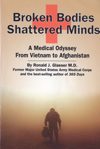 Former Army medical doctor Ronald J. Glasser’s report on the physical and emotional consequences of the war in Vietnam, 365 Days, came out in 1971 to rave reviews and big sales. Glasser framed the book around his 1968-69 tour as a draftee Army pediatrician at Camp Zama, where he wound up doing much more than care for the children of military personnel in Japan.
Former Army medical doctor Ronald J. Glasser’s report on the physical and emotional consequences of the war in Vietnam, 365 Days, came out in 1971 to rave reviews and big sales. Glasser framed the book around his 1968-69 tour as a draftee Army pediatrician at Camp Zama, where he wound up doing much more than care for the children of military personnel in Japan.
Glasser, along with the other medical personnel at Zama, was pressed into duty treating the war’s severely wounded on a daily basis. In his book, he wrote about the patients he saw, as well as the stories that his patients told about the war. It was not a pleasant picture.
“In a world of suffering and death, Vietnam is like a Walt Disney true-life adventure,” Glasser wrote, “where the young are suddenly left alone to take care of the young.” At the Army hospital, he said, “after a while it all began to seem so natural, the blind 17-year-olds stumbling down the hallway, or the shattered high school football player being wheeled to physical therapy.”
The book—one of the relatively few published about the war during the war—was widely and very favorably reviewed. Thomas Lask, in The New York Times, wrote of Glasser’s book: “Its quiet eloquence, its factual precision, its emotional restraint braided into the horror and pain of the subject matter make it a book of great emotional impact.” 365 Days became a best seller, and today often is rightly found in lists of must-read books about the Vietnam War.
After 1971, Glasser went on to write six more books on military medical topics. His latest, Broken Bodies, Shattered Minds, continues in that vein. It deals with the changing nature of warfare and the medical consequences of those changes, from the Civil War to today. Glasser concentrates on comparing military medicine (including psychiatry) in the Vietnam War with the current U.S. wars in Iraq and Afghanistan.
The book, Ronald Glasser says, is about “the physical, mental, and psychological costs of these wars, those real and those invisible wounds, the anguish and persistent suffering. Unlike all our other wars, the real legacy of Iraq and Afghanistan is not the graveyard, but the orthopedics ward, the neurosurgical unit, and the psychiatric outpatient department.”
Glasser, mixing first-person descriptions of his time in the Army during the Vietnam War with third-person reporting, does an excellent job comparing and contrasting what he saw then and has learned about today. The biggest medical differences in today’s wars have come about due to advances in the training of medics; the “growing sophistication” of battlefield medicine; and giant improvements in body armor technology. While that has cut down significantly on battlefield deaths today, more veterans are surviving with more serious wounds than ever before.
As Glasser puts it: “Our wars of bleeding to death [are] over, and in their place [are] amputations and traumatic brain injuries.” This has led, he notes, to “the orthopedic wards at Walter Reed becoming filled with numbers of multiple amputees not seen since the Civil War.”
Glasser succeeds well at his task. The book, though, appears to be less-than-thoroughly researched (several notes cite the notoriously unreliable Wikipedia), and there are mistakes, some of which could be typos. For instance: it was the 90th Personnel Replacement Battalion, not “Personal”; the A Shau Valley, not “Ashow”; 58,000 U.S. killed in Vietnam, not 52,000; Advanced Individual Training, not “Advanced Infantry Training.”
Notwithstanding its minor flaws, Broken Bodies, Shattered Minds is in the running for a couple of significant awards from Library Journal in its “Best Books of 2011” category and the American Library Association’s “Notable Books of 2011.”
History Publishing Company, 2011




